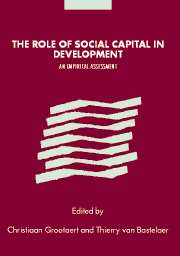Book contents
- Frontmatter
- Contents
- List of figures and maps
- List of tables
- List of boxes
- Notes on contributors
- Acknowledgments
- Foreword by Robert D. Putnam
- Introduction and overview
- Part 1 Social capital at the micro and macro levels: a conceptual discussion and review
- Part 2 The impact of social capital on development
- Part 3 The creation and transformation of social capital
- Conclusion: measuring impact and drawing policy implications
- Index
- References
Conclusion: measuring impact and drawing policy implications
Published online by Cambridge University Press: 22 September 2009
- Frontmatter
- Contents
- List of figures and maps
- List of tables
- List of boxes
- Notes on contributors
- Acknowledgments
- Foreword by Robert D. Putnam
- Introduction and overview
- Part 1 Social capital at the micro and macro levels: a conceptual discussion and review
- Part 2 The impact of social capital on development
- Part 3 The creation and transformation of social capital
- Conclusion: measuring impact and drawing policy implications
- Index
- References
Summary
The notion that social relations, networks, norms, and values matter in the functioning and development of society has long been present in the economics, sociology, anthropology, and political science literature. Only in the past ten years or so, however, has the idea of social capital been put forth as a unifying concept embodying these multidisciplinary views. The concept has been greatly stimulated by the writings of scholars such as James Coleman (1988, 1990) and Robert Putnam (1993). They, and many other writers, have attempted to define social capital rigorously and to identify conceptually sound and practically useful bounds of the concept (see the reviews in Grootaert 1997, Portes 1998, Woolcock 1998, Narayan 1999, Serageldin and Grootaert 2000, and Woolcock and Narayan 2000). The success of these efforts has been limited. While some progress has been made toward achieving consensus on the bounds of social capital, diversity of definitions across authors remains large. A general framework for thinking about social capital and for relating it to development has emerged, however (see Introduction and overview, p. 2).
In parallel with these conceptual endeavors, a growing number of efforts have been made to measure social capital and its impact on development and on various dimensions of well-being. These efforts have been hindered by the lack of consensus on how to define the concept. Researchers engaged in measurement exercises have therefore taken a pragmatic position on how to define and delineate social capital in order to facilitate its measurement.
- Type
- Chapter
- Information
- The Role of Social Capital in DevelopmentAn Empirical Assessment, pp. 341 - 350Publisher: Cambridge University PressPrint publication year: 2002
References
- 18
- Cited by

